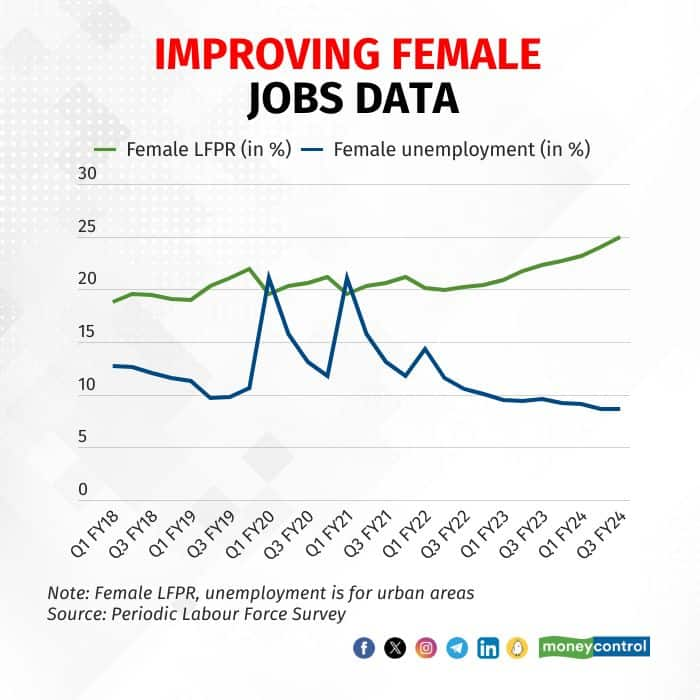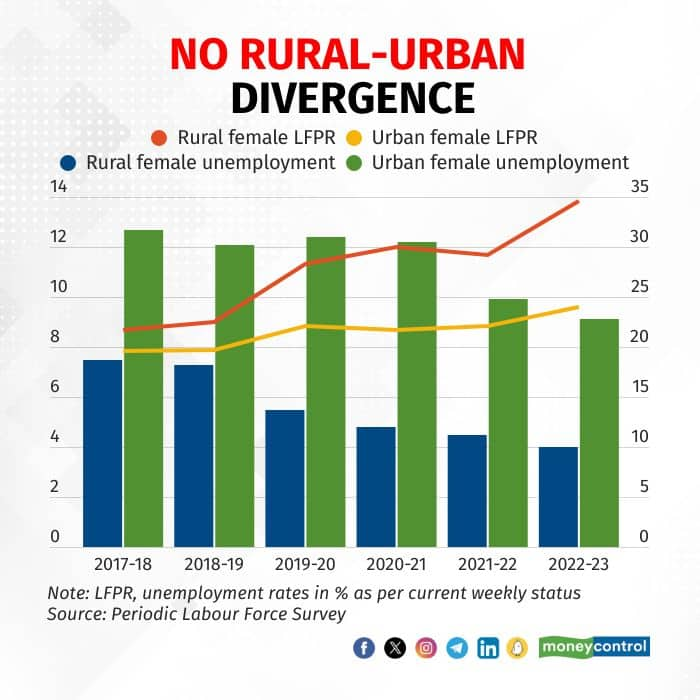Discover the latest business news, Sensex, and Nifty updates. Obtain Personal Finance insights, tax queries, and expert opinions on Moneycontrol or download the Moneycontrol App to stay updated!
The labour force participation rate refers to that percentage of working-age people in a category that are either working or looking for work.
While India is today the fifth-largest economy in the world, its ranking in the World Economic Forum's Gender Gap rankings was 127 out of 146 countries in 2023, behind Ethiopia, Sri Lanka, Bangladesh and Nepal. In terms of involvement in the workforce, India's female Labour Force Participation Rate (LFPR) is roughly half the global average of 47.3 percent, as per the World Bank.
According to the statistics ministry's latest Periodic Labour Force Survey (PLFS) released on February 12, the male urban LFPR for India stood at 74.1 percent in October-December 2023, while the female urban LFPR was 25 percent.
Also Read: India needs more female workers to become developed, says World Bank economist
But is female LFPR rising?
The answer is an unequivocal yes.
After rising to just above 21 percent in early 2020 from under 19 percent in mid-2018, the female LFPR understandably slumped to 19.6 percent in April-June 2020 due to the coronavirus pandemic and remained broadly stagnant until the end of 2021.

However, come 2022, and a steady uptick is clearly visible. From 20.2 percent in the last quarter of 2021, the female urban LFPR ended the next couple of calendar years at 22.3 percent and 25 percent, respectively.
Even more excitingly, the female unemployment rate is declining: from 10.5 percent in October-December 2021 to 9.6 percent in October-December 2022 and 8.6 percent in October-December 2023.

The picture is even brighter for rural India, with the female LFPR there rising from 21.7 percent in 2017-18 (July-June) to 34.6 percent in 2022-23. Meanwhile, the rural female unemployment rate has fallen from 7.5 percent to 4 percent over the same time period.
Where are women finding jobs?
So, what jobs are women taking up?

As it turns out, the proportion of women in the self-employed category – which includes being an unpaid helper in a household enterprise – has risen from 35.3 percent in the first quarter of 2022 to 40.3 percent in the last quarter of 2023.
The percentage of females in casual labour has declined to 6.7 percent from 8.1 percent.
But, worryingly, those in salaried jobs now account for 53 percent, down from 56.7 percent in January-March 2022.
Low-quality jobs?
While the data is clear, its interpretation is not.
A rise in the self-employed figure and fall in proportion of females with salaried jobs seems to suggest that the quality of jobs that are being taken up is low.
"Normally a shift from casual labour to regular wage labour signals an improvement in work conditions. However, Indian data does not show this shift," Ashwini Deshpande, professor of economics at Ashoka University, wrote in a December 2023 paper.
"Had the decline in casual labour been reflected in an increase in regular salaried jobs, it would have indicated an improvement in job quality. However, that is not the case. The increase in self-employment in agriculture could reflect disguised unemployment or underemployment, which refers to a situation where too many workers are doing too few jobs. This essentially means that women are engaged in agriculture but not to their full productive capacity," she added.
Not everyone shares this opinion.
Or are reforms working?
According to Bishwanath Goldar, non-resident senior fellow at the Institute of Economic Growth, and Suresh Chand Aggarwal, visiting professor at Institute of Human Development, the answer may instead lie in easing of labour regulations, progress made on financial inclusion, improvement in ease of doing business, a rapidly growing digital economy, and increase in household access to mobiles and the internet.
Goldar and Aggarwal also point to the shift of rural male workers from agriculture to non-agricultural activities as another factor.
"…most of the new jobs for rural women in agriculture (self-employed or otherwise) arose from increasing job opportunities for rural males in non-agricultural activities in rural or urban areas," the duo wrote in a paper published last month.
"Thus, it is ultimately the growth in the manufacturing and services sectors and the creation of employment opportunities in these sectors that made male workers in agriculture shift to non-agricultural activities, thus creating job opportunities for female workers in rural areas."